Welcome to the ultimate guide for your next adventure under the stars in one of America’s most breathtaking national parks! Whether you’re a seasoned camper or a first-timer, planning to camp in Yosemite is an experience unlike any other, brimming with awe-inspiring landscapes and the call of the wild. Our comprehensive list of tips is designed to ensure you not only secure your spot in the best campgrounds Yosemite but also revel in every moment of your outdoor escapade. From making crucial camping reservations to selecting the perfect site for car camping in Yosemite, we’ve got you covered. Let this Yosemite camping guide be your compass to navigating the majestic wilderness of Yosemite. So, grab your gear, and let’s embark on a journey through the heart of nature, where adventure awaits at every turn and memories are waiting to be made under the canopy of the Sierra Nevada!
Choosing the Best Campgrounds
When planning to camp in Yosemite, selecting the right campground is crucial for an unforgettable experience. Yosemite offers a variety of campgrounds, each offering unique vistas and experiences. Here’s what you need to know to choose among the best campgrounds Yosemite has to offer. Yosemite National Park is home to over a dozen campgrounds, each providing a distinct view of the park’s stunning scenery. From the soaring cliffs of El Capitan to the tranquil waters of Merced River, each campground offers a unique way to connect with nature. Delve into the best places to camp in Yosemite National Park.
Factors to Consider
- Scenery: Are you looking for a view of the iconic Half Dome, or do you prefer being near a stream? Yosemite’s diverse landscapes cater to all preferences.
- Accessibility: Some campgrounds are more accessible than others, with roads leading directly to or near camping spots, ideal for car camping in Yosemite.
- Amenities: Consider what amenities you need. Some campgrounds offer full services including showers and food storage, while others are more primitive.
Popular Campgrounds
- Upper Pines: Located in the heart of Yosemite Valley, this campground offers close proximity to Yosemite’s famous landmarks. It’s perfect for those who want to be in the center of it all.
- Tuolumne Meadows: For those seeking high elevation and stunning meadow views, Tuolumne Meadows is ideal, offering cooler temperatures and fewer crowds.
- Wawona: Nestled near the Mariposa Grove of Giant Sequoias, Wawona is great for families and those looking to explore the park’s south area. For those times you decide to trade the tent for a touch of comfort, explore Wawona Hotel & Yosemite Big Trees Lodge.
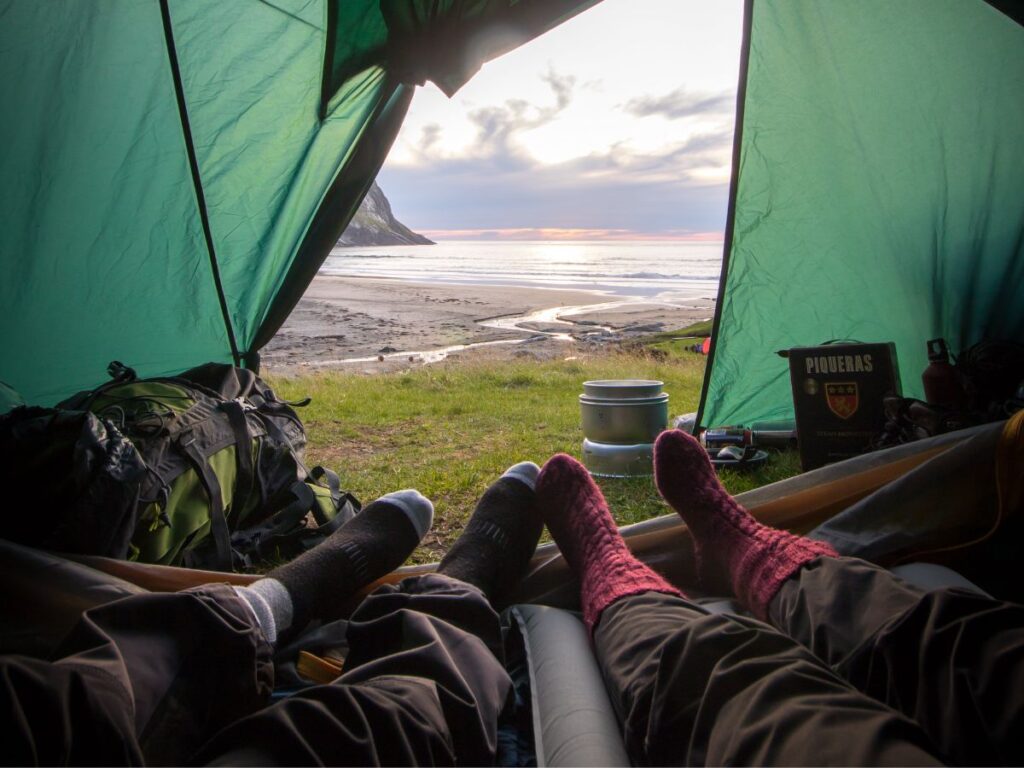
Making Camping Reservations
To guarantee your camping trip is as seamless as possible, visit Yosemite National Park reservation guide for tips on securing your spot. Securing a spot to camp in Yosemite can be competitive, especially during peak seasons. Yosemite’s campgrounds are in high demand, and spots can fill up quickly. To avoid disappointment, it’s crucial to make your reservations well in advance. This is especially true for popular campgrounds like Upper Pines or Camp 4.
Step-by-Step Guide on How to Make Reservations
- Check Availability: Determine your camping dates and check availability on the National Park Service’s official Yosemite camping reservation website.
- Create an Account: If you don’t have one, create an account on the reservation platform.
- Be Prompt: Know exactly when reservations open for your desired dates (typically five months in advance) and be ready to book as soon as they go live.
- Fill Out Details: Have all necessary information ready, including the size of your camping party and vehicle details if you’re planning for car camping in Yosemite.
If possible, consider camping during weekdays or in the shoulder seasons. Regularly check the reservation site for last-minute cancellations. Some of the lesser-known campgrounds may have more availability and can offer a more secluded experience.
20 Tips for Camping in Yosemite
Camping in Yosemite is an experience that combines adventure with the tranquility of nature. To make the most of your trip, follow these essential tips.
Research Campgrounds Early
Begin your journey by thoroughly researching the best campgrounds Yosemite has to offer. Yosemite boasts several campgrounds with varying features, from the magnificent views at Glacier Point to the serene settings near Mariposa Grove. Use resources like the official Yosemite National Park website to gather information.
Secure Reservations Promptly
Due to the popularity of Yosemite, obtaining a campsite can be competitive. Make your camping reservations as soon as they become available, typically five months in advance. Keep in mind the dates when reservations open up for each season, and be ready to book promptly to ensure your spot.
Choose the Right Campsite
Your camping experience can vary greatly depending on which site you choose to camp in Yosemite. Consider what’s important to you: Do you prefer being close to water? Do you need easy access for car camping in Yosemite? Or are you seeking a remote spot away from crowds? Evaluate the location, scenery, and accessibility of different campgrounds to find your ideal match.
Prepare for Varied Weather
Yosemite’s weather can be quite unpredictable. Be prepared for warm days and chilly nights, especially if you are camping at higher elevations. Pack layers of clothing, a waterproof jacket, and suitable sleeping gear to stay comfortable regardless of the weather.
Understand Campground Amenities
Different campgrounds in Yosemite offer various amenities. Some might have flush toilets and running water, while others offer a more rustic experience with vault toilets and no water access. Understanding what each campground provides can help you pack appropriately and set realistic expectations for your stay.
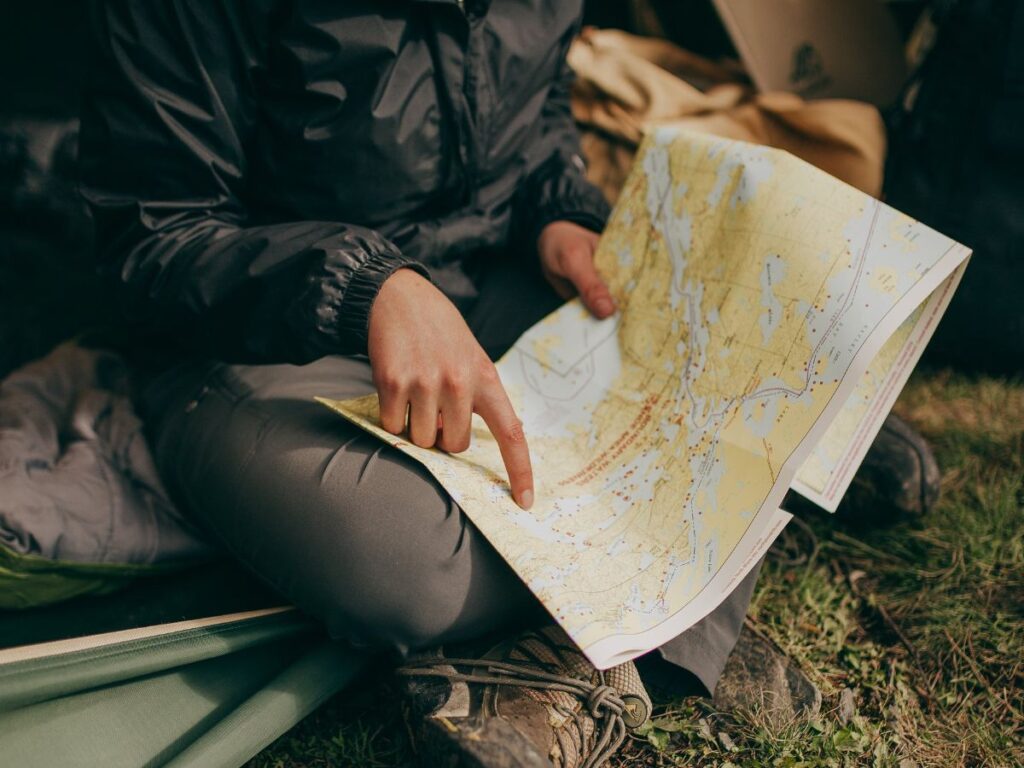
Practice Leave No Trace Principles
Yosemite is a treasure that demands our respect and care. Follow the Leave No Trace principles: pack out everything you bring in, stay on designated trails, and avoid disturbing wildlife and plants. This helps preserve the park’s natural beauty and integrity, ensuring that future generations can also enjoy the wonder of camp in Yosemite.
Store Food Securely
Yosemite is home to black bears and other wildlife that are attracted to human food. Use bear-proof containers or food storage lockers provided at many campsites. Proper food storage is critical for your safety and the bears’ well-being, and it’s a requirement when you camp in Yosemite.
Plan Meals in Advance
Preparing your meals beforehand can make your camping trip more efficient and enjoyable. Opt for easy-to-cook and nutritious meals that require minimal preparation. This not only saves time but also helps in managing waste and keeping your campsite clean. Exploring the top dining experiences in Yosemite National Park to ensure that your adventure is deliciously memorable.
Follow Campfire Rules
Campfires are a quintessential part of the camping experience, but they need to be managed responsibly. Always check for current fire regulations and restrictions in Yosemite. Use designated fire rings, keep fires small, and never leave them unattended. Before leaving, ensure the fire is completely extinguished.
Be Prepared for Wildlife Encounters
While the chance to see wildlife is a highlight for many who camp in Yosemite, it’s important to do so safely. Keep a safe distance from animals, never feed them, and be aware of how to respond if you encounter a bear or other wildlife. Educate yourself and your group about wildlife safety tips provided by the Yosemite camping guide.
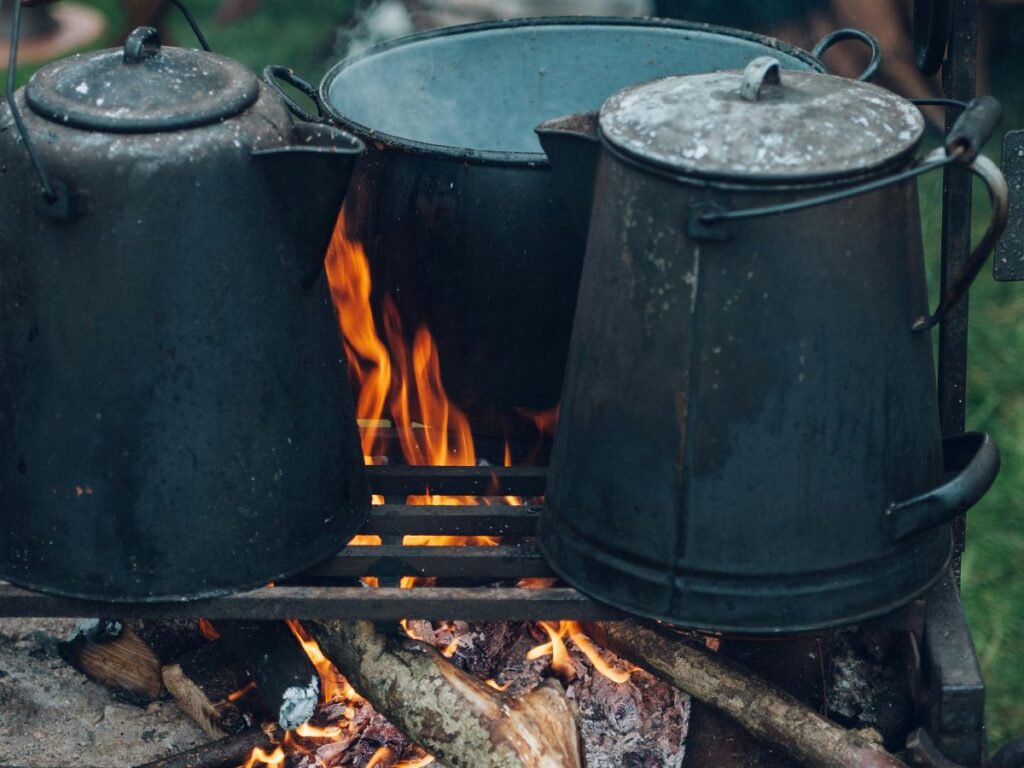
Familiarize Yourself with Park Regulations
Before you set out to camp in Yosemite, it’s crucial to familiarize yourself with the park’s regulations. These rules cover everything from campfire usage to noise levels and are designed to protect both the park and its visitors. Adherence to these regulations ensures a safe and enjoyable experience for everyone.
Consider Car Camping
For those new to camping or seeking convenience, car camping in Yosemite is an excellent option. It allows you to bring more gear and supplies, making your stay comfortable. Many campgrounds in Yosemite are accessible by car, but remember to check the specific campground’s accessibility when making your camping reservations.
Learn Basic First Aid
Knowing basic first aid is essential when camping in remote areas like Yosemite. Familiarize yourself with how to treat minor injuries, as medical help may not be immediately available. It’s also a good idea to carry a first aid kit with essential supplies.
Check Road Conditions
Yosemite’s mountainous terrain means road conditions can vary, especially in winter or early spring. Before you leave, check the current road conditions and any travel advisories. This is especially important for those planning to ‘car camp in Yosemite’, as some roads may be inaccessible during certain times of the year.
Pack Light but Efficiently
While it’s important to be prepared, overpacking can hinder your camping experience. Pack light but efficiently, bringing only the essentials and leaving any unnecessary items at home. This approach makes setting up camp easier and ensures you can move around the park more freely.
Stay Connected Wisely
While the idea of disconnecting is appealing, staying connected can be important for safety reasons. Inform someone about your itinerary and expected return. In areas with cell service, keep your phone charged for emergencies. However, remember that part of the camp in Yosemite experience is to enjoy the natural surroundings, so use technology sparingly.
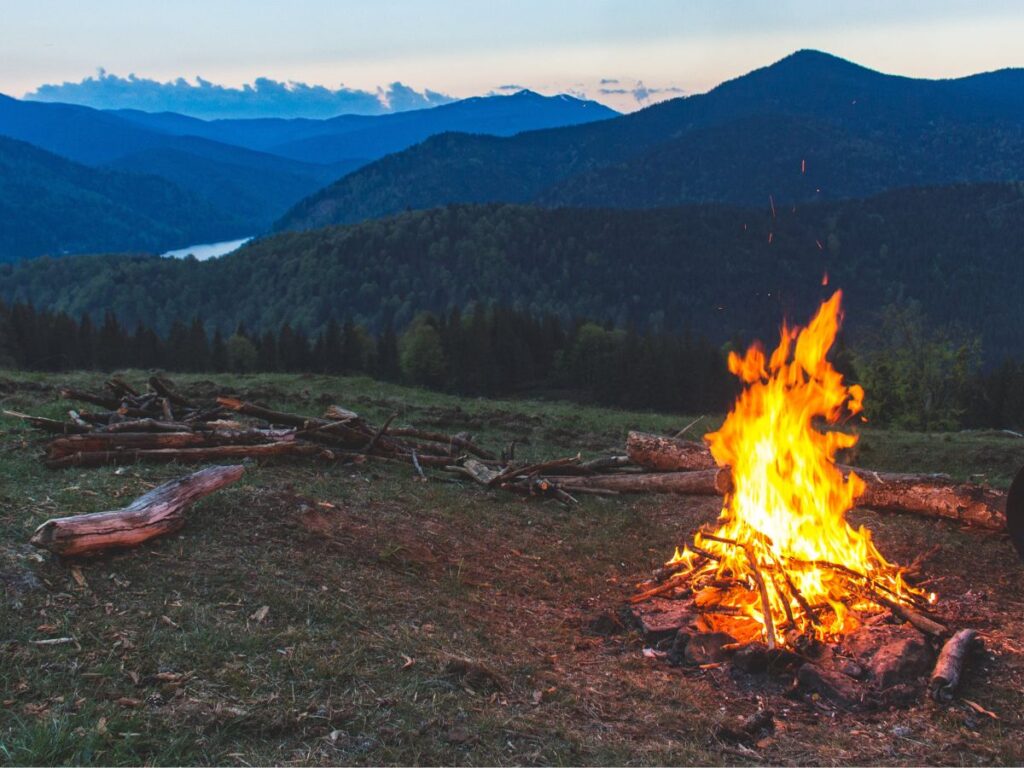
Document Responsibly
Yosemite’s breathtaking scenery is undeniably photogenic, but it’s important to document your experiences responsibly. Stick to trails and public areas to avoid damaging the ecosystem. Respect wildlife by observing from a distance and never feed or approach them for a photo. Remember, your actions can help preserve the park’s natural beauty.
Be Ready for Nighttime
The nights in Yosemite can be pitch dark, so be prepared with adequate lighting. Pack a reliable flashlight or headlamp (and extra batteries) for nighttime trips to the bathroom or if you need to navigate around your campsite. A soft-glow lantern can also create a pleasant atmosphere at your campsite after dark.
Respect Quiet Hours
Yosemite campgrounds enforce quiet hours, usually from 10 PM to 6 AM. This is not only to respect other campers but also to maintain the tranquil nature of the park. Avoid loud activities during these hours and keep your voices low to ensure everyone can enjoy the peacefulness of Yosemite.
Bring Comfortable Hiking Gear
Exploring Yosemite often involves hiking, so bring comfortable and appropriate gear. Good hiking boots are a must for traversing the park’s varied terrain. Dress in layers, as weather can change rapidly, and always carry a lightweight rain jacket. Proper hiking gear enhances your ability to explore and enjoy the park safely and comfortably.
Essential Camping Gear for Yosemite
Preparing for a camping trip in Yosemite requires thoughtful planning, especially when it comes to gear. Here’s a checklist of essential camping equipment, special considerations for car camping in Yosemite, and recommendations for weather-appropriate gear.
- A sturdy tent with rainfly, suited for varied terrain.
- Choose one rated for Yosemite’s nighttime temperatures.
- For added comfort against the hard ground.
- Portable stove, fuel, lighter, and cooking utensils.
- Bear-proof containers are a must in Yosemite.
- Filters or purification tablets, as not all water sources are safe to drink.
- Headlamps, flashlights, and extra batteries.
- Include personal medications, bandages, and antiseptic.
- For navigation, even if you plan to stay on marked trails.
- To carry your essentials, especially for day hikes.
- Comfortable camping chairs and table.
- Larger, more comfortable tent.
- Cooler for food and beverages.
- Additional cooking equipment.
- Weather in Yosemite can change rapidly. Bring layers, including moisture-wicking underlayers, a fleece or down mid-layer, and a waterproof outer layer.
- Waterproof hiking boots are recommended.
- Sunglasses, sunscreen, and a hat.
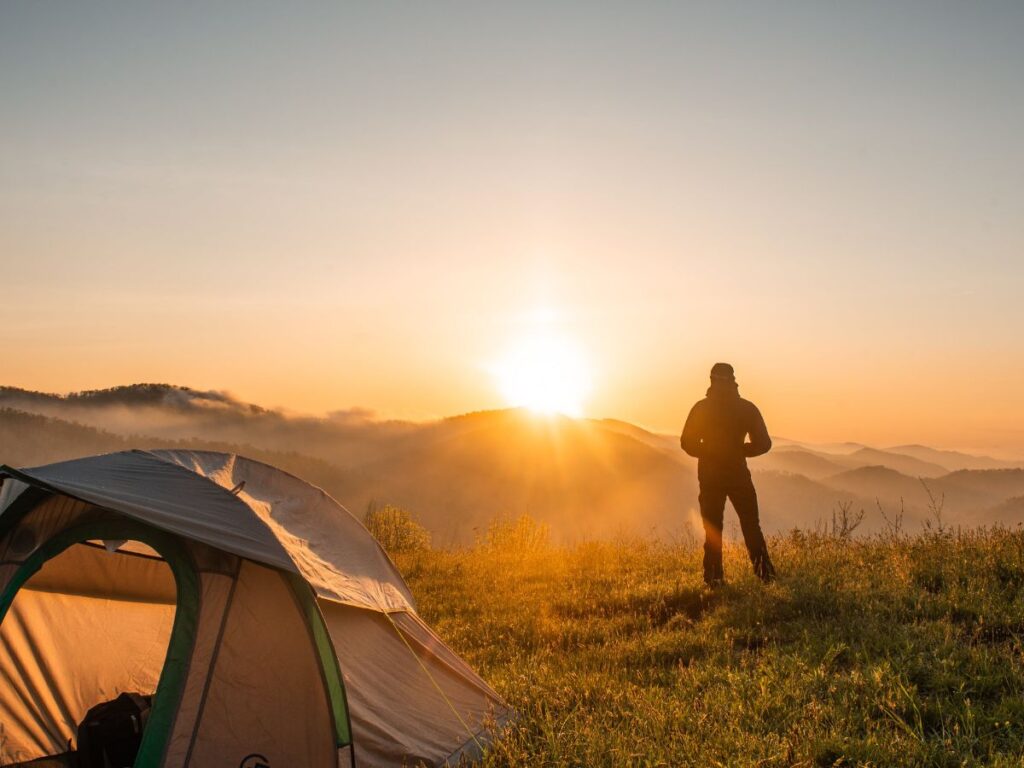
Activities While Camping
Yosemite National Park offers a plethora of activities for campers. Whether you’re a first-timer following Yosemite camping guide suggestions or a seasoned visitor, there’s something for everyone.
Popular Hiking Trails and Scenic Spots
- Yosemite Valley Loop Trail: Perfect for beginners, offering stunning views of Yosemite’s famous landmarks.
- Mist Trail: A more challenging hike leading to Vernal and Nevada Falls. Enhance your Yosemite camping adventure with a day hike on the Mist Trail.
- Mariposa Grove: Home to giant sequoias, ideal for a leisurely walk. Enrich your experience with a journey through the Mariposa Grove of Giant Sequoias.
Other Outdoor Activities
- Fishing: Many streams and lakes in Yosemite are great for fishing, but ensure to check for permit requirements. Our guide to fishing in Yosemite National Park will equip you with the know-how for a successful day at the park’s pristine waters.
- Bird Watching: Yosemite is home to over 250 bird species, making it a haven for bird watchers.
- Rock Climbing: For the adventurous, the park offers world-renowned climbing spots.
Incorporating Yosemite camping guide Advice for First-Timers
- Attend Ranger-Led Programs: Learn about the park’s history and wildlife.
- Stay on Marked Trails: Especially important for those unfamiliar with the park.
- Check Park Bulletins: For updates on trail conditions and safety information.
Safety Tips for Camping in Yosemite
Safety is paramount when camping in Yosemite National Park. Being prepared and aware of the surroundings can ensure a safe and enjoyable experience. Here are key safety tips, including weather considerations, navigation, and emergency procedures.
- Check Weather Forecasts. Make the most of your camping trip by staying informed about the seasonal weather patterns with our Yosemite National Park weather guide.
- Be prepared for varying temperatures. Carry waterproof and warm clothing, regardless of the season.
- In case of extreme weather conditions like wildfires or heavy snow, follow park updates and advisories.
- Even if you plan to use GPS, a physical map and compass are reliable backup tools.
- To preserve the park’s ecology and for your safety, always stay on marked trails.
Maximizing Your Camping Experience
To make your camp in Yosemite experience truly unforgettable, it’s important to immerse yourself fully in the park’s natural beauty and engage with the community. Here’s how you can maximize your camping experience.
Engaging with the Park Community and Educational Programs
- Participate in Ranger-Led Programs
- Join Guided Tours
- Connect with Fellow Campers
How to Capture Memories Responsibly (Photography Tips)
- Keep a safe distance from wildlife and stay on trails while taking photos.
- Utilize the golden hours of sunrise and sunset for the best natural lighting.
- When capturing memories, be considerate of other visitors who are also enjoying the park.
Key Takeaways
- Secure campground reservations well in advance, especially during peak seasons, and choose the right campsite based on your preferences for scenery, accessibility, and amenities.
- Pack essential gear tailored for Yosemite’s diverse weather conditions, including a reliable tent, sleeping bag, and weather-appropriate clothing. Consider the specifics of car camping if applicable.
- Practice Leave No Trace principles, store food securely to protect wildlife, and be aware of park rules and emergency procedures. Familiarize yourself with weather patterns and terrain navigation.
- Explore Yosemite’s abundant offerings, from hiking and bird watching to ranger-led educational programs. Tailor activities to suit all levels of experience, keeping first-timers in mind.
- Document your trip while respecting nature and other visitors. Use photography to capture the essence of Yosemite, but do so without disturbing the natural habitat or wildlife.
- Participate in park community events and educational programs for a more enriching camping experience.
- While exploring and activities are key, also take time to relax and soak in the natural beauty of Yosemite.
FAQs
- Can I find campgrounds in Yosemite suitable for car camping?
Yes, Yosemite offers several campgrounds that are suitable for car camping, including Upper Pines and Wawona. - What essential gear should I bring for camping in Yosemite?
Key items include a sturdy tent, a weather-appropriate sleeping bag, a first aid kit, bear-proof food containers, and reliable hiking gear. - What should I do if I encounter a bear in Yosemite?
Keep a safe distance, do not run, make yourself appear larger, and speak in a calm, loud voice. - Can I light a campfire at any Yosemite campground?
Campfires are allowed in designated fire rings, but check current fire restrictions first. - Are there any family-friendly activities in Yosemite for campers?
Yes, including easy hiking trails, ranger-led programs, and educational activities at visitor centers. - What’s the best way to enjoy Yosemite’s scenic spots without the crowds?
Start your day early or visit less popular trails and areas. - Is there cell phone coverage in Yosemite campgrounds?
Coverage is limited and varies by location, so don’t rely solely on cell phones for emergency communication. - Are pets allowed in Yosemite campgrounds?
Yes, but they must be leashed and are not allowed on most trails, in wilderness areas, or in public buildings. - Do I need a permit for backpacking or hiking in Yosemite?
A wilderness permit is required for overnight backpacking. Day hiking does not require a permit. - What’s the best time of year to camp in Yosemite?
Late spring to early fall offers the best weather, though summer is the busiest. Winter camping is available but more challenging due to snow. Don’t miss the chance to experience the park’s seasonal magic with our guide on visiting Yosemite National Park in winter.
